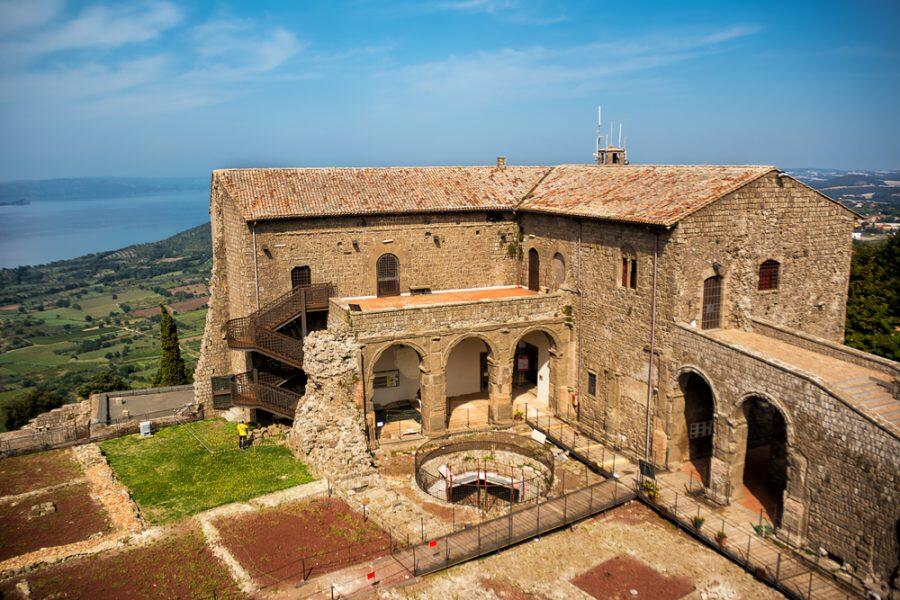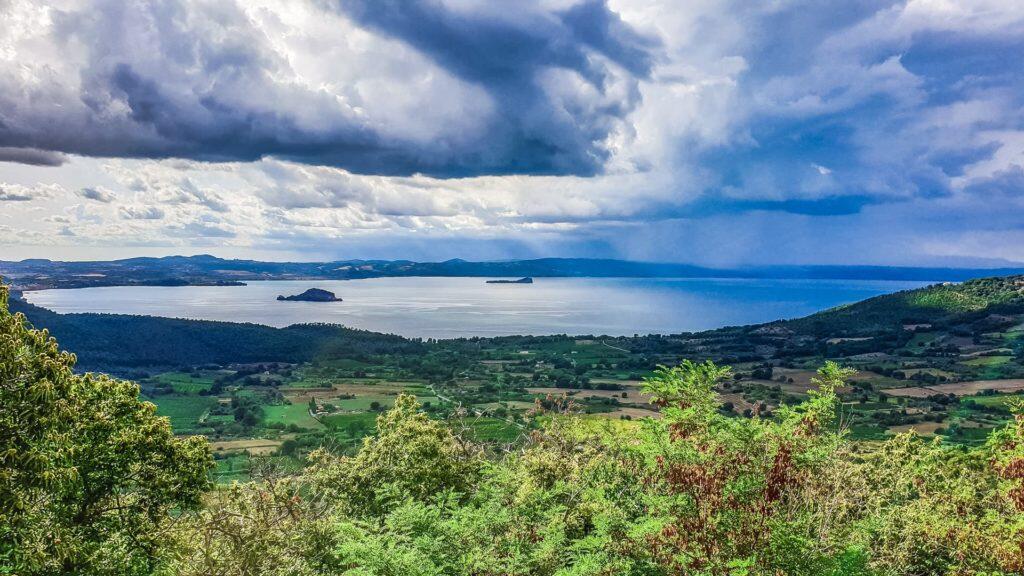
This itinerary will accompany you from the Roman coastline to Tuscia and back again, exploring Lazio as you go and encompassing the Tyrrhenian Sea, three lakes further inland and the ancient lands of the Etruscans. The entire route requires a minimum of three days, as the total distance spans more than 300 km. However, the undeniable charm of this region, not to mention the wealth of must-see locations that warrant
further investigation, makes it ideal for an extended stay. You would certainly not repent deciding to spend a full week here, given that this whole area contains some of the most enchanting and scenic villages in central Italy, guaranteeing lifelong memories long after your holiday is over. There are surprisingly few tourists, too, (with some notable exceptions) and you will be pleasantly surprised to find that you can enjoy plenty of
affordable and easily accessible gastronomic experiences without having to pay excessive prices or needing to book too far in advance. We begin our journey in Ladispoli, a popular seaside destination, practically around the corner from our first historical residence.
Castello Ruspoli di Cerveteri, a magnificent historical residence dating back to 1500, is one of Italy’s finest period buildings. The castello has previously played host to distinguished figures such as Pope Innocent VIII, who hunted boar in the nearby wild forests, and later, English writer D.H. Lawrence, musicians Händel and Caldara, and sculptors such as Benvenuto Cellini. It is located in the heart of Cerveteri, which is famous for its Etruscan necropolis (the Necropoli della Banditaccia) and for being the site of the most technologically advanced museum in upper Lazio. Even today, the property continues its long-standing tradition of hospitality – in the 20th century it welcomed royalty in the form of King Gustav of Sweden, an archaeology enthusiast, and British Princess Margaret – and has been transformed into a luxurious residence equipped with all modern comforts, including a massage centre and an in-house hairdresser. It is consequently an ideal starting point for visitors wishing to explore nearby attractions such as the Natural Monument Palude di Torre Flavia, a former marshland close to the Tyrrhenian Sea with its sandy dunes and network of lakes, coastal ponds and wetlands, now a refuge for various species of migratory birds. Continuing along the coast, you can also discover the Macchiatonda Regional Nature Reserve, the Castle of Santa Severa and the Castello Odescalchi in Santa Marinella. Between sightseeing stops, we recommend you taste the seafood at Isola del Pescatore right on the beach of Santa Severa. The beach club here, and particularly its restaurant is the permanent ‘flavour of the month’ for many celebrities and VIPs. Continue up the coast to Civitavecchia. This city not only serves as a port for those catching a ferry to Sardinia, but is also awash with museums and archaeological sites, including the Terme Taurine (otherwise known as Trajan's Baths), and the Michelangelo Fortress situated within the old port.

Archaeology is the common denominator between
Civitavecchia and Tarquinia, marking as it does the transition from the province of Rome to that of Viterbo, and the gateway into ancient Etruria. Be sure to include a visit to the Monterozzi Necropolis where you can admire the wall paintings inside the tombs, hailed as “the first chapter in the history of Italian painting” by Etruscology expert Massimo Pallottino, and the Archaeological Museum. For dining along the coast, why not try ‘Forma’ in Civitavecchia or ‘Capriccio di Mare’ in Montalto di Castro, while we suggest you take a detour to Francesca Castignani’s ‘Belle Hélène’ pastry shop while in Tarquinia. On reaching Montalto, our
itinerary veers sharply inland, avoiding any sightings of the nearby decommissioned nuclear power plant.
Regional 312 route steers us towards the more reassuring panorama of Lake Bolsena, which you will bypass as you proceed on to towards the city of Acquapendente. Often described as the ‘Jerusalem of Europe’ due to the presence of a small shrine in the cathedral’s crypt which resembles the Holy Sepulchre in the holy city, it contains stones said to be stained with Christ blood, brought to Italy by the crusaders. We are now approaching Tuscany, and it is here on the border between the two regions that our second destination is located. Castello di Proceno is a medieval castle built by the papacy to defend the Papal States, which still retains its original splendour as a pentagonal-shaped fortress. We propose you stay here on your first night (or second, if you have decided to also book accommodation at Castello dei Principi Ruspoli) in one of seven guest apartments. The estate features a tavern in the ancient cellars and a restaurant in the park. For nature-lovers, the Monte Rufeno Reserve is just a brief drive away.

The following day, we head towards Bolsena for a tour of the Rocca Monaldeschi della Cervara fortress, which houses exhibits on the geological and anthropic history of the lake area in its museum. Next on the agenda is a visit to the globally renowned village also called ‘The Dying City’. Civita di Bagnoregio owes its striking nickname to its unique position on an eroding tuff hill. A short distance away, straddling the border with Umbria, you will find the third historical residence on our itinerary, Castello di San Michele. Initially built in the 1100s and reconstructed in the mid-1500s on a tuff outcrop overlooking the Calanchi valley of
Civita di Bagnoregio, it has been converted into charming accommodation. The suites have private living rooms, the apartments overlook the castle square, and there is an infinity pool. Before continuing to Viterbo, we suggest you return on your tracks to Bolsena and then follow the lake as far as Montefiascone, synonymous for its production of the memorably entitled ‘Est! Est!! Est!!!’ wine. This
intriguing name is believed to have originated from a legend that is nearly a thousand years old. Wily
Bavarian bishop Johann Defuk, who was travelling through Italy in the company of Emperor Henry V, was an enthusiastic wine lover (to put it mildly), and enlisted his cupbearer to travel ahead of him on their way to Rome, with the mission of inscribing the Latin word ‘Est’ (meaning ‘there is’) on the inns to indicate the presence of good wine within its doors. When he arrived in Montefiascone, it was to discover that the local wine must have greatly pleased the cupbearer, as he had indicated the spot not once but three times, adding as many exclamations marks. Defuk clearly agreed with this assessment so much that he decided to settle in Montefiascone (where he is now buried) until his demise, caused, perhaps unsurprisingly, by ‘excessive consumption’! While here, you can visit the Antica Cantina Leonardi winery in the town centre, as well as the other main attraction, the Rocca dei Papi, so named because it served as the summer residence of the popes for several centuries. Between visits, indulge in a slice of tart from the delectable ‘Bar Giusti’ pastry shop. The most highly reputed winery in the surrounding area is without a shadow of a doubt the Famiglia Cotarella. You could easily spend a whole weekend or more in Viterbo, but we settled for proposing just one overnight stay at the Relais di Villa Rossi Danielli, with its lush gardens, olive groves and swimming pool. The residence now provides stunning ‘agritourism’ accommodation with 5 rooms, including a suite with a private living room and a fireplace. The Relais provides a splendid base for exploring the ‘City of the Popes’, a title given to Viterbo due to the fact that it took over from Rome and became the favoured papal seat for a period
of time in the 12th century. Before leaving, make sure to visit the papal residence, the wonderful San
Pellegrino district (best seen at night), the many fountains in the city, the Cathedral of San Lorenzo and some of the noble palazzos named after dynasties like the Chigi and Farnese families.

Our next destination is Vignanello, home to Castello Ruspoli, which boasts one of the most important and well-preserved Renaissance gardens in the whole of Europe. The style of the Italianate Garden reaches its zenith in the Viterbo region, in fact, as it is here that you will find the highest concentration of historic
gardens in the world, and Vignanello could justifiably be considered the most elegant, sophisticated and celebrated example of its kind. Castello Ruspoli is open for guided tours from March to November, by prior reservation. As we near the end of this journey, completing the loop and returning to the starting point, our itinerary has
yet to reveal two more lakes and another historical residence. The first of these is Vico Lake, just beyond
Caprarola, with the nearby castles of Soriano and Canepina, the stupendous Palazzo Farnese of Caprarola, and Ronciglione, with its distinctive ‘two-storey’ structure, which is listed as one the most beautiful villages in Italy. Driving through the ancient city park of Sutri, you may care to stop to examine its Amphitheatre and Mithraeum, the gardens of Villa Savorelli and the necropolis, before arriving at Lake Bracciano, where Castello Odescalchi stands proudly on its shores. The Castle is considered one of the most beautiful
Renaissance residences in Europe, thanks to the renovations commissioned by Napoleone Orsini and his son Gentil Virginio between 1470 and 1496. Owned by the Odescalchi family since the late 1600s, with a brief interruption during the French occupation of the Papal States, it now serves as a venue for private events and receptions and is also open to visitors daily. Finally, leaving Bracciano, take Provincial Road 4 back in the direction of Cerveteri and Ladispoli, the only potential distraction being the temptation to catch a glimpse of the lovely waterfall at Castel Giuliano, also known as the Cascata della Mola.